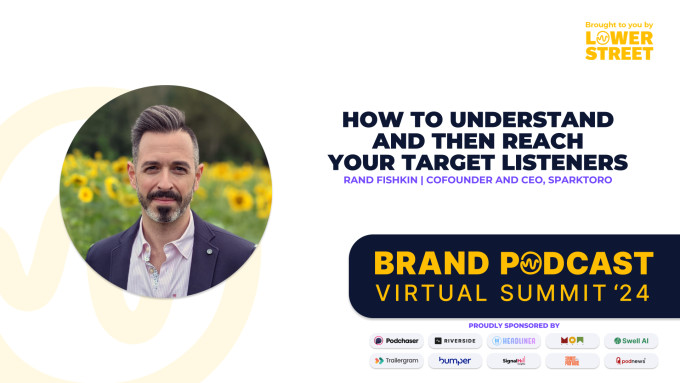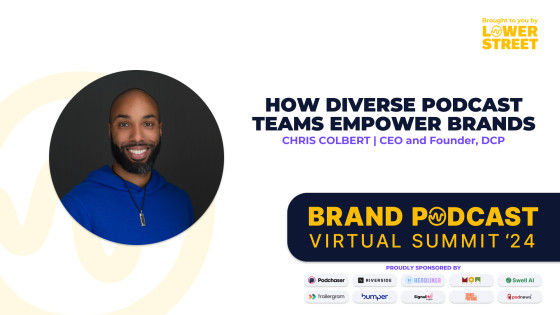Understanding and Reaching Your Podcast Audience
Contents

You need to know who they really are, what they do, why they want your product or service, and where you can find them. Give them what they want, when they need it, in a way that delights and surprises them and you’re unstoppable.
At our Brand Podcast Summit, Rand Fishkin, CEO of SparkToro, talked about strategies for understanding your audience, and how to best reach them. I’m going to share what I learned here.
The Importance of Audience Research
Rand shared why it’s so important to know your listener before hitting record.
A podcast may not be the right thing, or it may be. And let us first establish whether our audience or the audience that we believe reaches our audience listens to podcasts.
-Rand Fishkin
If your audience isn’t into podcasts, then launching one won’t help out your brand a ton. I love this first point – don’t make a podcast because your competitors are or because your CMO thinks it’s a cool idea. Make one because your audience wants it!
Once you know they listen to podcasts, you want to know what specific topics they engage with. Where they are, what they need, and how you can bring value to them. Defining your audience should lead your strategy, and be on every step of your podcasting (and overall marketing) journey.
So how can you get to know your audience?
Further Reading: Defining Your Ideal Podcast Listener
Strategies for Understanding Your Current Audience
Research is key. But how can you start to approach getting to know your audience? Normally we go directly for analytics collected from third parties - most of us have Googled around statistics at some point in our careers. But, quality data can also be gathered through surveys and interviews.
Truly, direct responses and research will give you the best response to your questions. Why? Because you’ll hear back from the exact people you want to reach, and who love your content. Ask around your audience by conducting surveys - on social, through newsletters, wherever you can.
If you aren’t finding much information through this tactic, Rand has another plan: try going one-on-one. Randomly select a group from your audience to chat with directly. Go through your email list and reach out to a small percentage personally, ask them for a minute of their time. Now, they may not all respond, but even a few genuine answers can really change how well you know your listeners.
Surveys and interviews will help you get the finer details of your audience, but it’s always good to look at the big picture. Tools like SimilarWeb and SparkToro can tell you a lot about who’s already interacting with your brand, or whose attention you’d like to grab. Both are databases of passively collected data that allow you to segment groups and see who is engaging with your website or accounts, or who is interacting with certain keywords. Then they share a wealth of data – they’ll tell you who else your audience is listening to, following, watching, and interacting with.
Now that you really know who you are talking to, you can make a podcast catering to what they want and what they need.
Who is going to Amplify your Podcast?
So, we know who we are talking to. We know who they are, what they want, and where to find them. But if you really want to create content that stands out as a trusted resource to these individuals, you’ll need to take it a step further.
Rand said it best:
“It's fine to serve your listeners wonderfully so that they say “I heard this podcast today, and it was really good. And I learned a lot I enjoyed my 30 min that I listened to it.” But that is not nearly as good as them saying “I just finished listening to this podcast. I need to send it to 10 people. I need to take a clip and share it on Linkedin, on Youtube, on Tiktok, or wherever.”
To make a great podcast, focus on creating something that your audience loves so much, they can’t wait to share.
Beyond your main audience, think about who is going to amplify your podcast, and why?
Focus on the Why
Take a scroll through your podcast platform of choice, and you’ll quickly realize the majority of podcasts today are interview-based. A lot of creators have created a podcast focused solely on the idea they’ll interview experts in the industry. That’s it. But what these podcasts are missing is the why, their driving purpose, and stance, that makes them unique.
Get clear on the why of your podcast, because that’s what’s going to make it recommendable.
I said before you hit record you need to know your audience. Well, you also need to know exactly what makes you unique. Lock down your UVP and be clear about what will make your content stand out from the competition, and what will make people want to share it.
Don’t just keep it an internal note, make sure your UVP drives your content. It should be so clear that your audience gets it right away.
Make your show compelling at first glance. The title, description, artwork, everything should show your audience the value you provide before they even press play.
When it comes to inviting guests on the show, make sure they back up your podcast’s position, and do your best to guide the conversation to provide unique value to your audience.
Follow that formula and your podcast will shine. You’ll be producing content way beyond the competition and gaining new listeners episode after episode.
Balancing Audience Interests
During my session with Rand, an attendee asked a very relevant question: how can we strike a balance between catering to the interests of our current audience and adapting to attract new listeners?
This can of course be challenging, but rewarding.
Rand recommended a strategy I think we could all benefit from. Alternate your content, but keep your message. Create one core content piece every so often that is focused on grabbing new audience members. But fill out the majority of your content with pieces created for individuals already in the target audience, who already engage with you.
What might this look like in Podcasting? Switch it up once every few months with either a standard or bonus episode. You could interview a big name, or controversial figure in your industry, or it could be that you change the style of the show for a deep dive, Q&A, or other format.
Ultimately, here’s the rule to follow: create content for who is most important to your business.
Your marketing should serve your business strategy needs. Full stop.
-Rand Fishkin
If you need to grow, then focus on growing. If you need more engagement and connection with your audience, then focus on serving those who are already on your radar.
Trends in Audience Research for Podcasting
Looking into the future, Rand knows there will be shifts in audience research for podcasting. We can all admit it’s inevitable with the direction technology is going.
These days, there is a phasing out of third-party cookies that will make the process of audience research a bit more complicated. That means creators may need to adapt their audience research approaches.
Then there’s the content on everyone’s mind: video.
With video content gaining much more traction and platforms like YouTube becoming a go-to channel for podcast consumption, we may have to rethink audience research strategies. More users are being pushed towards YouTube and video, rather than audio-only content.
We’re seeing that offering a more rounded-out content experience is becoming the way to gain a larger audience. That often means pairing video with audio. Yet, the YouTube algorithm may shape your brand’s audience very differently than podcasting audiences have been shaped in the past; it will take a new strategy.
Video content aside, Rand believes email lists are the best way to grow a podcast audience, and that’s not going out of style. We couldn’t agree more.
Further Reading: How to Grow Your Podcast Audience
Final Thoughts
The quest to really know and understand your audience never ends. You’ve got to always keep it in mind, and adapt when your audience’s needs and wants adapt. But by getting close to them, knowing who they really are, and tailoring unique content to them, they’ll be your biggest fans.
Let your audience amplify your show. The more you create for them, the more they’ll share and your listeners will grow.
Thinking about launching a podcast for your brand?
If you need a hand launching, producing, or promoting your branded podcast, the Lower Street team is here to help. Get in touch for a free consultation.
Contact us




